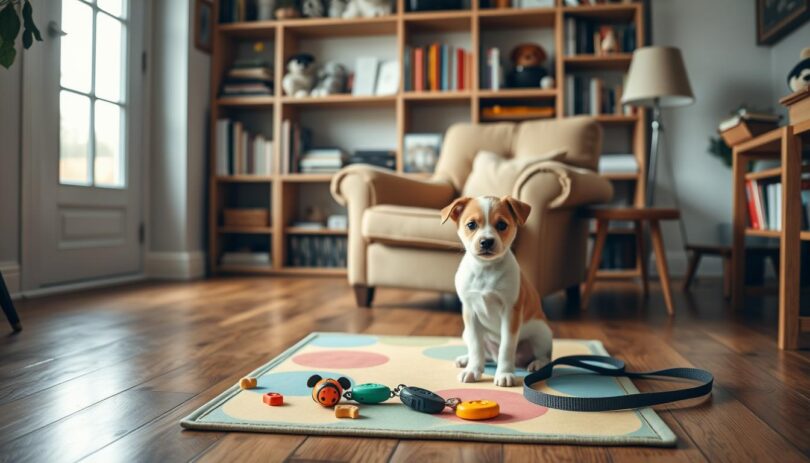Are you ready to welcome a new furry friend into your home? Bringing home a puppy is an exciting journey, but it comes with its own set of challenges. This guide is here to help you navigate the world of puppy training with confidence.
Training your puppy is more than just teaching commands—it's about building a strong bond and preventing future behavioral issues. Whether you're a first-time dog owner or looking to refine your skills, this guide will walk you through every step of the process.
In this guide, we'll cover everything you need to know about puppy training, from basic obedience to more advanced techniques. You'll learn how to get started immediately, even if you've never trained a dog before. Our expert advice will empower you to raise a well-behaved and happy companion.
By the end of this guide, you'll have the tools and knowledge to help your puppy thrive. Let's get started on this exciting journey together!
Understanding the Basics of Puppy Training
When you bring a new furry friend home, it's essential to lay a strong foundation for their development. Understanding the basics of puppy training sets the stage for a well-behaved and happy companion.
Preparing Your Home and Puppy-Proofing
Before your puppy arrives, ensure your home is safe. Secure any toxic substances, electrical cords, and fragile items. Consider using baby gates to restrict access to certain areas. These simple steps create a secure environment for your puppy to explore and grow.
A well-prepared home helps prevent accidents and reduces stress for both you and your puppy. It's a basic yet crucial step in their training and your peace of mind.
Recognizing Your Puppy’s Learning Needs
Your puppy's age and temperament play a significant role in their learning. For example, an 8-week-old puppy will have different needs compared to a 6-month-old. High-energy breeds like Labradors may require more stimulation and exercise than a quieter breed like a Bichon Frise.
Understanding these needs helps tailor your approach. Every puppy is unique, and recognizing these differences ensures a smooth transition into their new environment. With a lot of care and attention, you can create a structured space where they thrive.
Essential “puppy training advice” for New Owners
Bringing home a new companion is an exciting milestone, but it comes with challenges. To help you navigate this journey, here are some expert tips to ensure your new friend grows into a well-behaved and happy companion.
A key training tip is to focus on socialization. The critical window for socialization is between 3 to 14 weeks of age. During this time, introduce your puppy to various environments, people, and other animals. This early exposure can significantly reduce fear-based behaviors later in life.
Using a reward system is another crucial aspect. Positive reinforcement, such as treats or praise, encourages good behavior. This method is not only effective but also strengthens the bond between you and your puppy. Remember, consistency is key—clear commands and routines help your puppy understand what’s expected.
Working with an experienced trainer can also provide personalized guidance tailored to your puppy’s unique needs. They can help you address specific challenges and ensure you’re using the most effective techniques. With patience and the right approach, you can set your puppy up for a lifetime of good behavior and happiness.
Housebreaking and Potty Training Techniques
Mastering potty training is a cornerstone of raising a well-behaved dog. It requires patience, consistency, and a keen eye for your dog's signals. By establishing a routine and recognizing early cues, you can help your dog learn where it's appropriate to go.
Establishing a Consistent Daily Schedule
A structured daily schedule is vital for successful housebreaking. Start by planning regular times for meals, naps, and potty breaks. Dogs thrive on routine, and consistency helps them learn faster. Take your dog outside immediately after meals, playtime, and naps, as these are common times when they need to go.
As your dog grows, you can gradually extend the time between potty breaks. For younger dogs, frequent trips outside are essential, especially within the first few months. A consistent schedule not only helps with potty training but also strengthens the bond between you and your dog.
Identifying Early Potty Cues
Dogs often exhibit specific behaviors when they need to go. Sniffing, circling, or squatting are common signs. If you notice these cues, act quickly to avoid accidents. Every minute counts, especially in the early stages of training.
By paying close attention to these signals, you can guide your dog to the right spot every time. Over time, your dog will learn to go where they're supposed to, making the process easier for both of you.
Mastering Crate Training for a Secure Environment
Crate training is a powerful tool for creating a safe and comfortable space for your dog. It leverages their natural instinct to seek out a den, providing a sense of security and comfort. This method not only helps with housebreaking but also reduces anxiety and prevents destructive behavior.
Introducing the Crate Positively
Start by placing the crate in a busy area of your home, like the living room, to make it a part of your dog's environment. Leave the door open and fill the crate with your dog's favorite toys or a cozy blanket. This approach helps your dog view the crate as a welcoming space rather than a confinement area.
Once your dog is comfortable entering the crate on their own, you can introduce a consistent cue, such as “bedtime” or “settle,” to signal it's time to go inside. Reward your dog with treats or praise when they respond to the cue, reinforcing positive behavior.
Gradual Acclimation and Safety Tips
Begin with short periods of crate time while you're at home, gradually increasing the duration as your dog becomes more comfortable. Always supervise your dog during this process to ensure their safety and comfort.
Choose a crate that's the right size for your dog—large enough to stand, sit, and turn around, but not so big that it allows them to designate areas for elimination. A well-sized crate helps with housebreaking and prevents destructive habits.
A crate that's too small can cause stress, while one that's too large may lead to accidents. By introducing the crate gradually and maintaining a consistent routine, you can help your dog feel secure and reduce the risk of unwanted behaviors.
Implementing Reward-Based and Positive Reinforcement Methods
Positive reinforcement is a cornerstone of effective dog training, fostering a strong bond between you and your furry friend. By using rewards, you encourage desired behaviors and create a motivated learner.
Choosing High-Value Treats and Toys
Selecting the right treats and toys is crucial for successful training. Opt for high-value treats like small, tasty bites that your dog finds irresistible. These should be reserved for training to maintain their appeal. Engaging toys, such as interactive puzzle toys, can also keep your dog focused and excited about learning.
Using a variety of treats prevents boredom, ensuring your dog stays engaged. Toys add an element of fun, making training sessions enjoyable and dynamic.
Transitioning from Treats to Praise
As your dog becomes familiar with commands, you can gradually shift from treats to praise. Verbal affirmation and affectionate gestures become powerful rewards, reinforcing good behavior without overfeeding. Consistency is key—use clear cues and timely rewards to help your dog understand expectations.
Start by substituting praise for treats occasionally, then increase the frequency as your dog responds. This transition not only reduces reliance on food rewards but also strengthens your bond, fostering a sense of accomplishment and pride in your dog's achievements.
With patience and consistency, reward-based training can transform your dog into a well-behaved and eager learner. Remember, every small step is a victory, and positive reinforcement is the key to unlocking your dog's full potential.
Socialization: Expanding Your Puppy's World
Socialization is a cornerstone of raising a confident and well-adjusted dog. It’s about introducing your furry friend to the world in a way that fosters curiosity and calmness. This process begins early and continues as your dog grows, shaping their personality and how they interact with their environment.
Encouraging Positive Encounters with Other Dogs
Introducing your dog to other canines should be done thoughtfully. Start in familiar locations where your dog feels secure. Keep initial interactions one-on-one to prevent overwhelm. As your dog becomes more comfortable, you can gradually introduce them to new dogs in different settings. This approach helps build positive associations and reduces the risk of anxiety.
Building Confidence in New Environments
Exposing your dog to various environments is key to their development. Start with short visits to quiet parks or friend’s homes, then gradually move to busier areas. Consistent exposure helps your dog become confident in new settings. Positive reinforcement, such as treats and praise, can encourage calm behavior and reinforce good habits.
Practical Training Tips to Prevent Unwanted Behaviors
Every dog owner faces challenges with unwanted behaviors like jumping or chewing. The key is to address these issues before they become habits. Consistent training and positive reinforcement can make a big difference.
Managing Distractions and Impulse Control
Distracting environments can derail even the best training sessions. Start by identifying common distractions, such as other dogs or loud noises. Gradually expose your dog to these distractions during short sessions, rewarding calm behavior.
To regain your dog’s attention, use a clear, upbeat command like “focus” paired with a treat. This helps redirect their mind away from distractions. Over time, your dog will learn to stay focused even in busy settings.
Impulse control is another crucial aspect. Teach your dog to wait before meals or walks. This simple exercise helps them learn self-control. Positive cues like “wait” or “stay” can minimize unwanted behaviors like jumping or rushing.
Remember, every dog is unique. Be patient and adjust your approach as needed. With consistent practice and positive reinforcement, you can help your dog develop good habits that last a lifetime.
Creating an Effective, Balanced Training Schedule
Designing a well-rounded training schedule is essential for your dog's development. A structured yet flexible plan ensures your dog stays engaged and progresses consistently.
Integrating Play Sessions with Obedience Training
A balanced schedule should blend play with structured learning. This approach keeps your dog interested and makes training sessions more enjoyable. Start by dedicating specific times of the day to different activities, ensuring a mix of fun and focus.
Each training session should be short and engaging, ideally 10-15 minutes, with breaks in between. For example, you might have three short sessions each day, combining basic commands with interactive play. This structure helps maintain your dog's attention and prevents boredom.
Plan your day thoughtfully, allocating time for both structured learning and free play. For instance, mornings could focus on obedience drills, while afternoons might involve playtime or socialization. This balance supports overall development and keeps your dog mentally stimulated.
To get your dog actively engaged, use a variety of activities. Mix basic commands with fun exercises like agility or scent games. Over time, adjust the schedule as your dog grows, ensuring it remains challenging yet achievable.
A well-structured schedule not only aids in learning but also strengthens the bond between you and your dog. With consistency and flexibility, you can create a routine that works for both of you, fostering a happy and well-behaved companion.
Final Thoughts on Your Puppy Training Journey
Embarking on the journey of raising a new companion is both thrilling and rewarding. As you start this adventure, remember that patience, consistency, and positive reinforcement are your most powerful tools. Every small step, from teaching your dog to sit to helping them understand basic commands, is a meaningful milestone.
One of the most important aspects of this process is knowing when to start training. Begin with simple commands and gradually build up as your dog grows. Treats can be a helpful reward, but don’t overuse them. Over time, shift to praise and affection to keep your dog motivated without relying too much on food.
This journey is a job that requires dedication, but it’s also incredibly fulfilling. Every person who commits to these principles will see positive results over the coming weeks. Remember, consistency is key, and every effort you make now will shape your dog’s behavior for years to come.
As you move forward, revisit the guide’s principles whenever needed. Every step you take, backed by expert guidance, strengthens the bond between you and your furry friend. With time and care, you’ll raise a well-behaved, confident, and happy companion. Enjoy the journey!











Leave a Comment